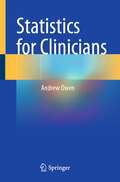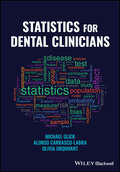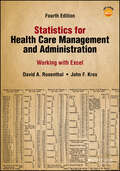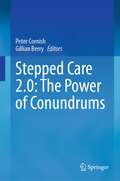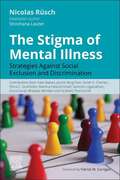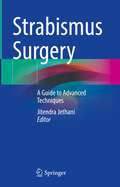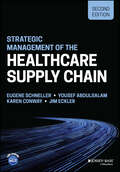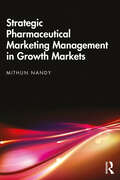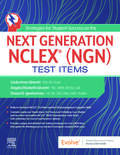- Table View
- List View
Statistics for Clinicians
by Andrew OwenThis book provides clinical medicine readers with a detailed explanation of statistical concepts using non-technical terms. This allows clinicians and others without specialist statistical knowledge to understand the medical literature where such concepts are used. Many examples from the medical literature are used to exemplify how these concepts are used in practice. Current books written for clinicians fall into two broad categories. Simple texts that are not designed to cover many important statistical concepts used in the medical literature. Comprehensive texts which cover many statistical principles in detail, including statistical theory, but which are more challenging to read and do not always cover many important statistical techniques used in the medical literature. This book assists in the understanding of these techniques.Statistics for Clinicians covers such topics in a robust non-technical manner accessible to clinicians and is intended for hospital consultants, junior doctors and general practitioners. Undergraduates in biomedical sciences and medicine may also find some sections valuable.
Statistics for Dental Clinicians
by Michael Glick Alonso Carrasco-Labra Olivia UrquhartSTATISTICS FOR DENTAL CLINICIANS Enables clinicians to understand how biostatistics relate and apply to dental clinical practice?? Statistics for Dental Clinicians??helps dental practitioners to understand and interpret the scientific literature and apply the concepts to their clinical practice. Written using clear, accessible language, the book breaks down complex statistical and study design principles and demonstrates how statistics can inform clinical practice. Chapters cover the basic building blocks of statistics, including clinical study designs, descriptive and inferential statistical concepts, and interpretation of study results, including differentiating between clinical and statistical significance. An extensive glossary of statistical terms, as well as graphs, figures, tables, and illustrations are included throughout to improve reader comprehension. Select readings accompany each chapter.?? Statistics for Dental Clinicians??includes information on:?? How to understand and interpret the scientific language used in the biomedical literature and statistical concepts that underlie evidence-based dentistry What is statistics and why do we need it, and how to effectively apply study results to clinical practice Understanding and interpreting standard deviations, standard errors, p-values, confidence intervals, sample sizes, correlations, survival analyses, probabilistic-based diagnosis, regression modeling, and patient-reported outcome measures Understanding and interpreting absolute risks, relative risks and odds ratios, as well as randomized controlled trials, cohort studies, case-control studies, cross-sectional studies, meta-analysis, bias and confounding With comprehensive coverage of a broad topic, written using accessible language and shining light on statistical complexity often found in writings related to clinical topics, Statistics for Dental Clinicians??is an essential guide for any dental practitioner wishing to improve their understanding of the biomedical literature.
Statistics for Dental Clinicians
by Michael Glick Alonso Carrasco-Labra Olivia UrquhartSTATISTICS FOR DENTAL CLINICIANS Enables clinicians to understand how biostatistics relate and apply to dental clinical practice?? Statistics for Dental Clinicians??helps dental practitioners to understand and interpret the scientific literature and apply the concepts to their clinical practice. Written using clear, accessible language, the book breaks down complex statistical and study design principles and demonstrates how statistics can inform clinical practice. Chapters cover the basic building blocks of statistics, including clinical study designs, descriptive and inferential statistical concepts, and interpretation of study results, including differentiating between clinical and statistical significance. An extensive glossary of statistical terms, as well as graphs, figures, tables, and illustrations are included throughout to improve reader comprehension. Select readings accompany each chapter.?? Statistics for Dental Clinicians??includes information on:?? How to understand and interpret the scientific language used in the biomedical literature and statistical concepts that underlie evidence-based dentistry What is statistics and why do we need it, and how to effectively apply study results to clinical practice Understanding and interpreting standard deviations, standard errors, p-values, confidence intervals, sample sizes, correlations, survival analyses, probabilistic-based diagnosis, regression modeling, and patient-reported outcome measures Understanding and interpreting absolute risks, relative risks and odds ratios, as well as randomized controlled trials, cohort studies, case-control studies, cross-sectional studies, meta-analysis, bias and confounding With comprehensive coverage of a broad topic, written using accessible language and shining light on statistical complexity often found in writings related to clinical topics, Statistics for Dental Clinicians??is an essential guide for any dental practitioner wishing to improve their understanding of the biomedical literature.
Statistics for Health Care Management and Administration: Working with Excel (Public Health/Epidemiology and Biostatistics)
by David A. Rosenthal John F. KrosThe must-have statistics guide for students of health services Statistics for Health Care Management and Administration: Working with Excel introduces the uses of statistics in healthcare management and administration using the features and functions of Microsoft Excel. The book introduces students to statistics within the context of health care, focusing on the major data and analysis techniques used in the field. Step-by-step instructions in the latest version of Excel and numerous annotated screen shots make examples easy to follow and understand. This updated fourth edition provides the same content and explanations that have made the previous editions so popular, offering revisions drawn directly from universities where the book has been used. All content has been brought current with the newest version of excel, and changes in the field of healthcare administration are covered as well. Statistics for Health Care Management and Administration gets students off to a great start by introducing statistics in the context of their chosen field. Learn the basics of statistics in the context of Excel Understand how to acquire data and display it for analysis Master important concepts and tests, including regression Turn test results into usable information with proper analysisThis book not only helps students develop the necessary data analysis skills, but also boosts familiarity with important software that employers will be looking for.
Statistics for Health Care Management and Administration: Working with Excel (Public Health/Epidemiology and Biostatistics)
by David A. Rosenthal John F. KrosThe must-have statistics guide for students of health services Statistics for Health Care Management and Administration: Working with Excel introduces the uses of statistics in healthcare management and administration using the features and functions of Microsoft Excel. The book introduces students to statistics within the context of health care, focusing on the major data and analysis techniques used in the field. Step-by-step instructions in the latest version of Excel and numerous annotated screen shots make examples easy to follow and understand. This updated fourth edition provides the same content and explanations that have made the previous editions so popular, offering revisions drawn directly from universities where the book has been used. All content has been brought current with the newest version of excel, and changes in the field of healthcare administration are covered as well. Statistics for Health Care Management and Administration gets students off to a great start by introducing statistics in the context of their chosen field. Learn the basics of statistics in the context of Excel Understand how to acquire data and display it for analysis Master important concepts and tests, including regression Turn test results into usable information with proper analysisThis book not only helps students develop the necessary data analysis skills, but also boosts familiarity with important software that employers will be looking for.
Stem cell and Non-stem Cell Components of Breast Milk
by Indumathi Somasundaram Pankaj Kaingade Ramesh BhondeThis book reviews the cellular and non-cellular components of human breast milk and their contribution to infant growth and development. It also discusses various cellular growth factors in breast milk, including stem cells and their significance in promoting optimal growth, immunity and regeneration in neonates and in mitigating several neonatal diseases. Further, the book examines variations in the macronutrient concentrations of human milk in different lactation stages and maternal factors. It also describes the potential of antimicrobial proteins/peptides in human milk to provide innate immunity to infants. Lastly, it explores the regenerative therapeutic applications of breast milk cells in feeding infants.
Stem Cell-Based Neural Model Systems for Brain Disorders (Methods in Molecular Biology #2683)
by Yu-Wen Alvin Huang ChangHui PakThis detailed volume presents validated and well-adapted procedures involving humanized and/or stem cell-based neural model systems that have proven helpful in better understanding the essential brain functions involved in the pathogenesis of brain disorders. The book explores the generation of multiple neural cell types in 2D and 3D as well as cutting-edge techniques to assay neural function. Written for the highly successful Methods in Molecular Biology series, chapters include introductions to their respective topics, lists of the necessary materials and reagents, step-by-step and readily reproducible laboratory protocols, and tips on troubleshooting and avoiding known pitfalls. Authoritative and practical, Stem Cell-Based Neural Model Systems for Brain Disorders serves as an essential resource for researchers and students in neuroscience, stem cell biology, and related fields.
Stepped Care 2.0: The Power of Conundrums
by Peter Cornish Gillian BerryStepped Care 2.0: A Paradigm Shift in Mental Health, by Dr Peter Cornish, made a compelling argument for why the existing mental health care system has consistently struggled to meet the needs of clients from all walks of life, and laid out key principles and guidelines for how the system could be changed. But what challenges are involved in putting these ideas into practice? Stepped Care 2.0: The Power of Conundrums features essays, interviews, and arguments from a wide range of contributors who have tried to do just that. The Power of Conundrums dives deep into the practical application of the Stepped Care 2.0 model (SC2.0), looking at the ways SC2.0 has succeeded, the difficulties administrators face when implementing it, and how it could be improved. Chapters touch on topics including: the evidence for stepped care, the way SC2.0 can be stymied by the Western cultural values that dominate mental healthcare, implementation science and SC2.0, the risk paradigm and SC2.0, the model’s one-at-a-time approach to therapy, what co-design means in an SC2.0 context, a case study on how implementing SC2.0 can go wrong, the understanding of recovery put forward by the model, and how SC2.0 can work for clients experiencing complex, persistent, or chronic mental health issues. Each chapter is followed by a reflection from Cornish, and the book concludes with a roundtable discussion about how SC2.0 can evolve to meet the challenges it faces. This text brings theory and practice together by including an updated version of Stepped Care 2.0: A Paradigm Shift in Mental Health, as well as the full text of Stepped Care 2.0: The Power of Conundrums.
Stereotactic Body Radiation Therapy: Principles and Practices
by Yasushi NagataThe second edition of the well-received book updates the knowledge of clinical treatment, radiobiology, physics, and instrumentations to provide a comprehensive description of stereotactic body radiation therapy (SBRT). Clinical aspects include indications and prescriptions for diseases treated with SBRT and clinical trial details. The chapters associated with physics cover quality assurance, patient immobilization devices, respiratory motion management, and treatment planning. It also illustrates the latest devices and provides know-how for safe and reliable treatment that differs from conventionally fractionated radiotherapy. In this second edition, the future of SBRT using artificial intelligence in the post-COVID-19 world also discussed. Stereotactic Body Radiation Therapy 2nd Edition - Principles and Practices enrich the readers' understanding of patient-friendly cancer care. Radiation oncologists, medical physicists, medical dosimetrists, radiation therapists, senior nurses, medical oncologists, and surgical oncologists interested in radiotherapy will benefit from this practical guide. Since the last edition, there has been significant progress in the field, and the book renews the facts and evidence based on cutting-edge research.
The Stigma of Mental Illness - E-Book: Strategies Against Discrimination and Social Exclusion
by Nicolas RueschPeople with mental illness are often painfully familiar with overt prejudice or more subtle forms of mistreatment. The stigma and discrimination associated with their disorders can have effects in several areas of life: in social interactions, in work and healthcare settings, in the legal system and the media. Many withdraw due to shame and do not seek help. In turn, stigma can prove to be a more serious problem than the disorder itself. Yet too little is done to reduce stigma and its impact. The Stigma of Mental Illness: Strategies Against Discrimination and Social Exclusion offers up the knowledge necessary to understand and fight against stigma and discrimination. It will be invaluable to all health professionals, social workers, healthcare managers and policy makers with an involvement or interest in mental illness. Broad coverage of the forms and consequences of stigma Specific treatment of stigma in relation to diagnoses such as dementia and autism Perspectives and strategies of a service user and a relative Up-to-date concepts regarding exclusion and discrimination Practical strategies for service users, relatives, healthcare professionals and policy makers
Still Life with Bones: 'I defy you not to be moved' - Sue Black
by Dr Alexa HagertyAn anthropologist working with forensic teams and victims' families to investigate crimes against humanity in Latin America explores what science can tell us about the lives of the dead in this haunting account of grief, the power of ritual, and a quest for justice."Exhumation can divide brothers and restore fathers, open old wounds and open the possibility of regeneration-of building something new with the pile of broken mirrors that is loss and mourning."Over the course of Guatemala's thirty-year armed conflict -the longest ever in Central America-over 200,000 people were killed. During Argentina's military dictatorship in the seventies, over 30,000 people were disappeared. Today, forensic anthropologists in each country are gathering evidence to prove atrocities and seek justice. But these teams do more than just study skeletons-they work to repair families and countries torn apart by violence.In Still Life with Bones, anthropologist Alexa Hagerty learns to see the dead body with a forensic eye. She examines bones for evidence of torture and fatal wounds-hands bound by rope, cuts from machetes-but also for signs of a life lived: to articulate how life shapes us down to the bone. A weaver is recognized from the tiny bones of the toes, molded by years of kneeling before a loom; a girl is identified alongside her pet dog. In the tenderness of understanding these bones, Hagerty discovers how exhumation serves as a ritual in the naming and placement of the dead, and connects ancestors with future generations. She shows us how this work can bring meaning to families dealing with unimaginable loss, and how its symbolic force can also extend to entire societies in the aftermath of state terror and genocide. Encountering the dead has the power to transform us, making us consider each other, our lives, and the world differently.Weaving together powerful stories about investigative breakthroughs, grieving families, histories of violence, and her own forensic coming of age, Hagerty crafts a moving portrait of the living and the dead."Touching, but achingly honest-a most amazing account of training as a forensic anthropologist. When Hagerty talks about "lives being violently made into bones," I defy you not to be moved. The text is unflinching, but then the crimes and the victims deserve nothing less. I guarantee this will make you think long and hard about cruelty and human rights and the dedication and humanity of the forensic scientist." - PROFESSOR DAME SUE BLACK
Stimmtherapie mit Erwachsenen: Theorie und Praxis für Ausbildung, Studium und Lehre (Praxiswissen Logopädie)
by Sabine S. Hammer Anna Teufel-DietrichAnamnese, Diagnostik und die Wahl der richtigen Stimmtherapie gehören zu den Grundlagen in der Logopädie und Stimmtherapie. Das Standardwerk in der 7. Auflage für Logopäd*innen und Sprachtherapeut*innen vermittelt verständlich und kompakt die Kenntnisse zur Anatomie des Kehlkopfes, Physiologie und Pathophysiologie des Stimmapparates sowie das systematische Vorgehen bei Anamnese und Diagnostik. Ausführlich vorgestellt werden aktuelle Therapiekonzepte, zahlreiche praktische Übungen und Behandlungsmöglichkeiten bei speziellen Störungsbildern. Plus Online-Material: Befund- und Diagnostikbögen sowie Videos zu Behandlungsbeispielen mit der SN More Media
Stoelting's Anesthesia and Co-Existing Disease E-Book
by Roberta L. Hines Stephanie B. JonesA valuable resource for anesthesia providers at all levels of training and practice, Stoelting's Anesthesia and Co-Existing Disease, 8th Edition, provides concise, thorough coverage of pathophysiology of the most common diseases and their medical management relevant to anesthesia. Noted authority Dr. Roberta L. Hines and new editor Dr. Stephanie Jones lead a stellar team of contributing authors who provide clear, detailed guidance on successfully managing or avoiding complications stemming from pre-existing conditions. Presents detailed discussions of common diseases, as well as highlights of more rare diseases and their unique features that could be of importance in the perioperative period. Includes the latest practice guidelines, easy-to-follow treatment algorithms, bulleted key points, and more. Contains two new chapters on Nutritional Diseases: Obesity and Malnutrition and Chronic Pain, and significantly revised content on valvular heart disease, heart failure and cardiomyopathies, pericardial disease and cardiac trauma, endocrine disease, diseases of aging, pregnancy-associated diseases, and more. Features abundant figures, tables, diagrams, and photos that provide fast access to the most pertinent aspects of every condition and clarify critical points regarding management. Examines specific anesthesia considerations for special patient populations, including pediatric, obstetric, and elderly patients. Ideal for anesthesiologists in practice and for anesthesia residents in training and preparing for boards.
Stoma Care Specialist Nursing: A Guide for Clinical Practice
by Maddie White Angie PerrinThis book provides specialist and general nurses with a comprehensive guide to the art and science of stoma care nursing, from the Association of Stoma Care Nurses UK, the only association for SCNs in UK.The chapters follow a schematic outline of knowledge required for nurses caring for patients who are undergoing stoma surgery; from the essence of nursing to the management of patients living with a long term condition. It also presents and discusses the issues surrounding the clinical picture such as prescription and community issues as well as sources of support available for patients. This text serves as an excellent resource for all disciplines of health care staff caring for individuals living with a stoma.
Stories from ICU Doctors: Navigating and conquering adversity
by Diane Dennis Aaron Calhoun Rahul Khanna Cameron Knott Peter Vernon van HeerdenThe intensive care unit (ICU) is a specialised hospital ward where the ‘sickest-of-the-sick’ patients, often with life-threatening illness, receive around-the-clock monitoring and life support. There is a wide spectrum of conditions managed, and these present unique challenges for those who work in this field. Written in lay language by experienced ICU doctors (Intensivists), Psychiatrists, healthcare professionals outside of medicine and other stakeholders, “Stories from ICU doctors” provides insight and commentary around the nature and management of stressors for senior doctors working in the ICU. The first five sections of the book describe the distinctive nature of the ICU environment: the human factors involved, the characteristics of thriving Intensivists, the emotions they experience, and how they behave in response. The final three sections provide a synthesis of the advice of these clinicians for both current and future Intensivists, the advice from those who surround the Intensivist both at work and at home; and some concluding remarks about trainee suitability and selection for intensive care medicine. This book is for ICU patients and their families, it is for the families of ICU doctors, it is for doctors from other specialities, it is for the nurses and others that work alongside ICU doctors, and for anyone considering a career in ICU medicine and those who care for them. We share these stories in hope that readers might better appreciate the human side of these doctors, better understand the complex working environment in which they practice, and perhaps better empathize with their stressors and struggles. Most importantly, this book is also for the ICU doctors who currently work within the specialty, to validate their feelings and experiences, and ultimately provide support by reminding them that they are not alone in navigating the difficulties they face.
Stories in Midwifery: Reflection, Inquiry, Action
by Katharine Gillett Karen Mclaughlin Loretta Musgrave Jessica Wood Allison CumminsThis insightful book and accompanying video resource present a collection of perspectives relating to different issues around birthing and midwifery. Through the voices of mothers, midwives, students, health professionals and family members, you will build empathy and understanding, reflect, and learn to apply innovative approaches in your own practice. The book covers a range of topics, such as midwifery continuity of care, place of birth, multiple pregnancy, complex pregnancies, congenital birth abnormalities, supporting culturally and linguistically diverse women, anxiety and depression, and working with women with physical and/or intellectual disabilities. Stories in midwifery provides teaching and learning strategies ideal for students and practising midwives alike. Readers will develop the skills, attitudes and mindfulness necessary for working in partnership with women, childbearing people and their families across a variety of settings. 22 chapters addressing a range of topics across the childbearing continuum 35 video ‘personal stories’ across a range of topics related to pregnancy, birth and the postnatal period A framework for reflection, inquiry and action – relates stories to your own practice Teaching and learning strategies for each story Weblinks, references and further reading to support learning Transcripts of all interviews included at the back of the book An eBook (with videos embedded) included in all print purchases Supports midwifery curricula; suitable for both undergraduate and postgraduate levelsNew topics identified by student midwives as the areas where they need supporting resources to help consolidate learning4 new chapters11 new videos
Stories of Addiction Recovery: The G-CHIME Model (Emerald Points)
by Lisa Ogilvie Jerome CarsonStories of Addiction Recovery explores first-hand structured accounts of addiction recovery through the G-CHIME model. G-CHIME is an adaptation to the CHIME model of mental health recovery, specifically targeted at addiction recovery. Identifying important components of recovery (Growth, Connectedness, Hope, Identity, Meaning in life, and Empowerment), G-CHIME considers aspects of positive psychology such as empowerment and hope as well as recognizing elements of addiction recovery such as connection and meaning in life. Publishing recovery stories in this way Stories of Addiction Recovery contributes positive literature to an area that is conventionally viewed with a negative bias, building away from the long-standing stigmatization associated with addiction and substance misuse. The first-hand accounts of shared experiences, lessons learnt, and the growth achieved can highlight to others what is possible in their own recovery.
Stories of Addiction Recovery: The G-CHIME Model (Emerald Points)
by Lisa Ogilvie Jerome CarsonStories of Addiction Recovery explores first-hand structured accounts of addiction recovery through the G-CHIME model. G-CHIME is an adaptation to the CHIME model of mental health recovery, specifically targeted at addiction recovery. Identifying important components of recovery (Growth, Connectedness, Hope, Identity, Meaning in life, and Empowerment), G-CHIME considers aspects of positive psychology such as empowerment and hope as well as recognizing elements of addiction recovery such as connection and meaning in life. Publishing recovery stories in this way Stories of Addiction Recovery contributes positive literature to an area that is conventionally viewed with a negative bias, building away from the long-standing stigmatization associated with addiction and substance misuse. The first-hand accounts of shared experiences, lessons learnt, and the growth achieved can highlight to others what is possible in their own recovery.
Stories of Survival: The Paradox of Suicide Vulnerability and Resiliency among Asian American College Students
by Amy WongCollege suicides are a growing social problem in the United States. Suicide is the second leading cause of death on university campuses and more than half of all college students report experiencing some level of suicide ideation in their lifetime. Asian American students are particularly vulnerable to suicide ideation, yet these students also show strong resiliency, leading to lower rates of suicide deaths than their peers. Stories of Survival explores the paradox of suicide vulnerability and resiliency among Asian American college students using one-on-one interviews collected during the global pandemic. This narrative research uses a strength-based approach to understand how Asian American college students live with their suicidal tendencies. It offers a deeply felt examination of the history of mental health challenges that the Asian American undergraduate population facefrom intergenerational trauma to racial microaggressionsand the coping strategies, protective factors, and life skills these students build to develop resiliency and well-being. Finally, Stories of Survival ends with practical recommendations and a call to action for colleges and universities to address this important and urgent mental health crisis. Stories of Survival shines a critical light on a frequently overlooked population in mental health research and the ways we can improve resiliency among our most vulnerable communities.
Strabismus Surgery: A Guide to Advanced Techniques
by Jitendra JethaniThis edited volume on squint covers newer, advanced surgeries that are now utilized globally to achieve superior patient outcomes. The topics include adjustable sutures, ciliary vessel-sparing surgery, superior oblique split lengthening, pulleys in surgery and pulley Faden, periosteal fixation of lateral rectus, muscle transplantation, loop myopexy, superior rectus transposition, advanced surgeries of inferior oblique and muscle transplantation. Chapters include notes on the surgical technique, personal experience of the expert, problems and limitations of the procedure, tips and tricks for improving outcomes, and modifications that may happen in future. Strabismus surgery has seen major refinements in the last few years. Now surgeons have more options than ever before to consider when planning surgery for their patients. Advances in strabismus surgery is for surgeons who have been doing horizontal strabismus surgery and are now keen to progress to advanced procedures.
Strategic Management of the Health Care Supply Chain
by Eugene Schneller Yousef Abdulsalam Karen Conway Jim EcklerA systems approach to understanding the needs of today’s healthcare supply chain Strategic Management of the Healthcare Supply Chain offers a big-picture overview and a proven strategic framework for supply chain management in healthcare. It also addresses concrete strategies for risk management, partnerships, logistics, performance assessment, information technology, and beyond. Readers will gain a comprehensive understanding of the issues facing the healthcare supply chain and the opportunities that present themselves as we look toward the future. Written by a team of authors with both research expertise and practical experience in healthcare supply chain, this broad and impactful book teases out the complexities within the supply chain field and the healthcare ecosystem. The healthcare industry is evolving rapidly, and the role of the supply chain is shifting in response. Institutions and practitioners are collaborating more closely than ever with supply chain leaders. This shift introduces new opportunities and challenges at the level of healthcare delivery. Additionally, the role of supply chain in safeguarding the social determinants of health—food, transportation, critical health-related products—is rapidly expanding, especially in historically underserved populations. This revised edition takes a holistic approach to the needs of people and organizations, yielding strategies that will improve both economic and health outcomes. Gain the understanding you need to work toward building a mature supply chain organization Develop perspective on how the needs of the healthcare supply chain are shifting in the modern era Holistically assess supply chain performance and improve clinical, financial, and operational outcomes Identify opportunities to generate value, improve alliances, and cut costsThis book will be of interest to graduate students in the health sector and supply chain programs, as well as working clinicians, health sector managers, and supply chain leaders. Policymakers looking to create a more resilient healthcare supply chain in the wake of COVID-19 will also find valuable insight inside.
Strategic Management of the Health Care Supply Chain
by Jim Eckler Karen Conway Eugene Schneller Yousef AbdulsalamA systems approach to understanding the needs of today’s healthcare supply chain Strategic Management of the Healthcare Supply Chain offers a big-picture overview and a proven strategic framework for supply chain management in healthcare. It also addresses concrete strategies for risk management, partnerships, logistics, performance assessment, information technology, and beyond. Readers will gain a comprehensive understanding of the issues facing the healthcare supply chain and the opportunities that present themselves as we look toward the future. Written by a team of authors with both research expertise and practical experience in healthcare supply chain, this broad and impactful book teases out the complexities within the supply chain field and the healthcare ecosystem. The healthcare industry is evolving rapidly, and the role of the supply chain is shifting in response. Institutions and practitioners are collaborating more closely than ever with supply chain leaders. This shift introduces new opportunities and challenges at the level of healthcare delivery. Additionally, the role of supply chain in safeguarding the social determinants of health—food, transportation, critical health-related products—is rapidly expanding, especially in historically underserved populations. This revised edition takes a holistic approach to the needs of people and organizations, yielding strategies that will improve both economic and health outcomes. Gain the understanding you need to work toward building a mature supply chain organization Develop perspective on how the needs of the healthcare supply chain are shifting in the modern era Holistically assess supply chain performance and improve clinical, financial, and operational outcomes Identify opportunities to generate value, improve alliances, and cut costsThis book will be of interest to graduate students in the health sector and supply chain programs, as well as working clinicians, health sector managers, and supply chain leaders. Policymakers looking to create a more resilient healthcare supply chain in the wake of COVID-19 will also find valuable insight inside.
Strategic Pharmaceutical Marketing Management in Growth Markets
by Mithun NandyIndia is the largest provider of generic drugs globally. The Indian pharmaceutical sector supplies over 50% of the global demand for various vaccines and, as a result, holds an important position in the global pharmaceutical sector. This book is a comprehensive study of pharmaceutical marketing management in the Indian context and similar growth markets. The book introduces the fast-paced and multi-faceted discipline of pharmaceutical marketing management through an in-depth discussion on the genesis and evolution of its marketing concept. Combining theory and practice, it offers a strategic approach to pharmaceutical marketing from an organizational and business perspective and explicates the practical applications of it. Richly supported by case studies, the book brings together fresh perspectives and approaches equally useful for students and professionals. This book will be of interest to academicians, advanced students, and practitioners of pharmaceutical marketing and pharmaceutical management. It will also be beneficial to those interested in business strategy, decision-making, and international marketing.
Strategic Pharmaceutical Marketing Management in Growth Markets
by Mithun NandyIndia is the largest provider of generic drugs globally. The Indian pharmaceutical sector supplies over 50% of the global demand for various vaccines and, as a result, holds an important position in the global pharmaceutical sector. This book is a comprehensive study of pharmaceutical marketing management in the Indian context and similar growth markets. The book introduces the fast-paced and multi-faceted discipline of pharmaceutical marketing management through an in-depth discussion on the genesis and evolution of its marketing concept. Combining theory and practice, it offers a strategic approach to pharmaceutical marketing from an organizational and business perspective and explicates the practical applications of it. Richly supported by case studies, the book brings together fresh perspectives and approaches equally useful for students and professionals. This book will be of interest to academicians, advanced students, and practitioners of pharmaceutical marketing and pharmaceutical management. It will also be beneficial to those interested in business strategy, decision-making, and international marketing.
Strategies for Student Success on the Next Generation NCLEX® (NGN) Test Items - E-Book
by Linda Anne Silvestri Angela Elizabeth Silvestri Donna D. IgnataviciusNext Generation NCLEX®–style practice questions of all types are illustrated through stand-alone case studies and unfolding case studies directed toward each of the six cognitive skills. Detailed test-taking strategy for each question provides clues for analyzing and uncovering the correct answer option. NCSBN Clinical Judgment Measurement Model (NCJMM) is included throughout with case scenarios that integrate the six clinical judgment cognitive skills. In-depth rationales include both correct and incorrect answers. NGN Tip boxes highlight the most important nursing concepts needed for exam success. Additional resources on the Evolve website allow you to interactively engage with each question from the book plus additional questions.
